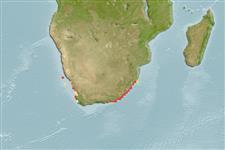Environment: milieu / climate zone / depth range / distribution range
Ökologie
seewasser; brackwasser demersal; tiefenbereich 10 - ? m. Subtropical; 28°S - 34°S
Southeast Atlantic: Mossel Bay to Natal in South Africa.
Length at first maturity / Size / Gewicht / Alter
Maturity: Lm 57.5 range ? - 70 cm
Max length : 200 cm TL Männchen/unbestimmt; (Ref. 3198); common length : 100.0 cm TL Männchen/unbestimmt; (Ref. 3507); max. veröff. Gewicht: 80.0 kg (Ref. 4537)
Rückenflossenstacheln (insgesamt): 11; Rückenflossenweichstrahlen (insgesamt): 10-11; Afterflossenstacheln 3; Afterflossenweichstrahlen: 8. Reddish, bronzy or golden-yellow in color; young with a blotch behind dorsal fin.
Found near rocky banks in coastal waters including estuaries. Adults solitary and territorial. Feeds on octopus, crabs and fish, especially Spondyliosoma. The flesh is highly esteemed, but the liver is poisonous due to high vitamin A content which causes hypervitaminosis. Popular angling fish. Largest of the porgies.
Life cycle and mating behavior
Geschlechtsreife | Fortpflanzung | Ablaichen | Eier | Fecundity | Larven
Smith, J.L.B. and M.M. Smith, 1986. Sparidae. p. 580-594. In M.M. Smith and P.C. Heemstra (eds.) Smiths' sea fishes. Springer-Verlag, Berlin. (Ref. 3198)
IUCN Rote Liste Status (Ref. 130435)
Bedrohung für Menschen
Poisonous to eat (Ref. 3507)
Nutzung durch Menschen
Fischereien: weniger kommerziell; Sportfisch: ja
Mehr Information
ReferenzenAquakulturAquakultur ProfilZuchtlinienGenetikElectrophoresesVererbbarkeitKrankheitenVerarbeitungNutrientsMass conversion
PartnerBilderStamps, Coins Misc.LauteCiguateraGeschwindigkeitSchwimmstilKiemenoberflächeOtolithsGehirngrößeSehfähigkeit
Tools
Zusatzinformationen
Download XML
Internet Quellen
Estimates based on models
Preferred temperature (Ref.
123201): 15 - 24, mean 22.2 °C (based on 10 cells).
Phylogenetic diversity index (Ref.
82804): PD
50 = 1.0000 [Uniqueness, from 0.5 = low to 2.0 = high].
Bayesian length-weight: a=0.01549 (0.00889 - 0.02698), b=3.04 (2.89 - 3.19), in cm total length, based on LWR estimates for this species & (Sub)family-body (Ref.
93245).
Trophic level (Ref.
69278): 4.5 ±0.61 se; based on food items.
Generation time: 14.6 ( na - na) years. Estimated as median ln(3)/K based on 2
growth studies.
Widerstandsfähigkeit (Ref.
120179): niedrig, Verdopplung der Population dauert 4,5 - 14 Jahre. (K=0.08; tm=5-7; tmax=30;).
Fishing Vulnerability (Ref.
59153): Very high vulnerability (80 of 100).
Climate Vulnerability (Ref.
125649): Very high vulnerability (92 of 100).
Nutrients (Ref.
124155): Calcium = 29 [17, 56] mg/100g; Iron = 0.833 [0.448, 1.585] mg/100g; Protein = 20.2 [19.2, 21.3] %; Omega3 = 0.36 [0.22, 0.60] g/100g; Selenium = 37.5 [16.0, 74.5] μg/100g; VitaminA = 9.94 [2.73, 33.75] μg/100g; Zinc = 0.486 [0.332, 0.711] mg/100g (wet weight);
